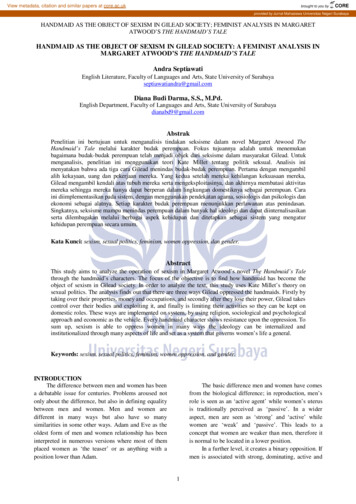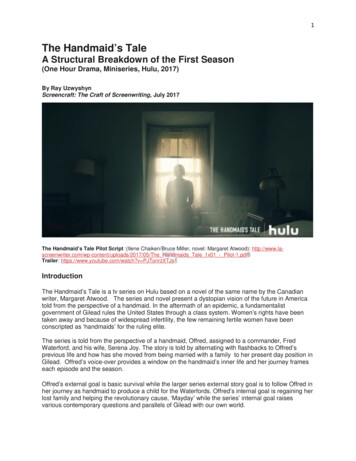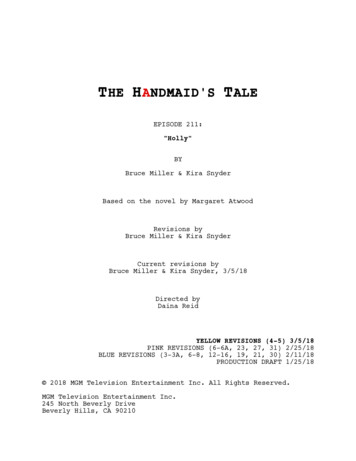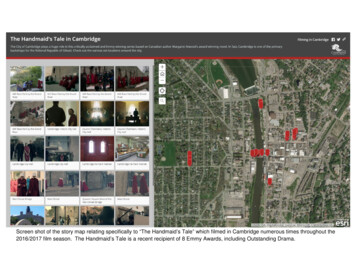
Transcription
View metadata, citation and similar papers at core.ac.ukbrought to you byCOREprovided by Jurnal Mahasiswa Universitas Negeri SurabayaHANDMAID AS THE OBJECT OF SEXISM IN GILEAD SOCIETY; FEMINIST ANALYSIS IN MARGARETATWOOD’S THE HANDMAID’S TALEHANDMAID AS THE OBJECT OF SEXISM IN GILEAD SOCIETY: A FEMINIST ANALYSIS INMARGARET ATWOOD’S THE HANDMAID’S TALEAndra SeptiawatiEnglish Literature, Faculty of Languages and Arts, State University of Surabayaseptiawatiandra@gmail.comDiana Budi Darma, S.S., M.Pd.English Department, Faculty of Languages and Arts, State University of Surabayadianabd9@gmail.comAbstrakPenelitian ini bertujuan untuk menganalisis tindakan seksisme dalam novel Margaret Atwood TheHandmaid’s Tale melalui karakter budak perempuan. Fokus tujuannya adalah untuk menemukanbagaimana budak-budak perempuan telah menjadi objek dari seksisme dalam masyarakat Gilead. Untukmenganalisis, penelitian ini menggunakan teori Kate Millet tentang politik seksual. Analisis inimenyatakan bahwa ada tiga cara Gilead menindas budak-budak perempuan. Pertama dengan mengambilalih kekayaan, uang dan pekerjaan mereka. Yang kedua setelah mereka kehilangan kekuasaan mereka,Gilead mengambil kendali atas tubuh mereka serta mengeksploitasinya, dan akhirnya membatasi aktivitasmereka sehingga mereka hanya dapat berperan dalam lingkungan domestiknya sebagai perempuan. Caraini diimplementasikan pada sistem, dengan menggunakan pendekatan agama, sosiologis dan psikologis danekonomi sebagai alatnya. Setiap karakter budak perempuan menunjukkan perlawanan atas penindasan.Singkatnya, seksisme mampu menindas perempuan dalam banyak hal ideologi dan dapat diinternalisasikanserta dilembagakan melalui berbagai aspek kehidupan dan ditetapkan sebagai sistem yang mengaturkehidupan perempuan secara umum.Kata Kunci: sexism, sexual politics, feminism, women oppression, dan gender.AbstractThis study aims to analyze the operation of sexism in Margaret Atwood’s novel The Handmaid’s Talethrough the handmaid’s characters. The focus of the objective is to find how handmaid has become theobject of sexism in Gilead society. In order to analyze the text, this study uses Kate Millet’s theory onsexual politics. The analysis finds out that there are three ways Gilead oppressed the handmaids. Firstly bytaking over their properties, money and occupations, and secondly after they lose their power, Gilead takescontrol over their bodies and exploiting it, and finally is limiting their activities so they can be kept ondomestic roles. These ways are implemented on system, by using religion, sociological and psychologicalapproach and economic as the vehicle. Every handmaid character shows resistance upon the oppression. Tosum up, sexism is able to oppress women in many ways the ideology can be internalized andinstitutionalized through many aspects of life and set as a system that governs women’s life a general.Keywords: sexism, sexual politics, feminism, women oppression, and gender.INTRODUCTIONThe difference between men and women has beena debatable issue for centuries. Problems aroused notonly about the difference, but also in defining equalitybetween men and women. Men and women aredifferent in many ways but also have so manysimilarities in some other ways. Adam and Eve as theoldest form of men and women relationship has beeninterpreted in numerous versions where most of themplaced women as ‘the teaser’ or as anything with aposition lower than Adam.The basic difference men and women have comesfrom the biological difference; in reproduction, men’srole is seen as an ‘active agent’ while women’s uterusis traditionally perceived as ‘passive’. In a wideraspect, men are seen as ‘strong’ and ‘active’ whilewomen are ‘weak’ and ‘passive’. This leads to aconcept that women are weaker than men, therefore itis normal to be located in a lower position.In a further level, it creates a binary opposition. Ifmen is associated with strong, dominating, active and1
HANDMAID AS THE OBJECT OF SEXISM IN GILEAD SOCIETY; FEMINIST ANALYSIS IN MARGARETATWOOD’S THE HANDMAID’S TALEprotector – women is defined as the opposite. They areassociated with weak, dominated, passive and needsprotection. Men are also associated with subject whilewomen are the object, be it in sexual context or ingaze. What is important about men and womendifferentiation, at most situations, women tend to beoppressed and gain less benefit than men do. Womenare to work in domestic areas because they are seen asincapable, such as being a housewife, nursing thechildren and other traditional gender role. Women whoreject this traditional role are classified as deviant orthey are allowed to work like men, but gain lowerwages and more underestimation.The reaction as a result of marginalization ofwomen over male is known as feminism movement.Theoretically, feminism criticizes on ‘the asymmetryof gender relations’ (Culler 64). There are a lot ofkinds of feminism, but basically feminism begins asthe reaction toward an idea which is called sexism.Sexism comes from patriarchal ideology. Firstly,patriarchal ideology is a belief that promotes “womenare innately inferior to men” (Tyson 85). It based onthe idea that “physical size, shape body and chemistry”make men more superior than women. As a result,women are seen as the ‘other’ or the ‘second’ – womenare oppressed and underestimated in social life.Women are believed as less capable than men andcannot do “men’s job”. Women are assigned totraditional gender role that generally puts women‘behind’ men.Feminists argue that the difference in men andwomen’s role are not something natural; it is a socialconstruction or cultural programming (Tyson 86). Menare not born masculine. Both men and women aretaught, educated and programmed to be masculine orfeminine. This is the reason why feminists divided‘sex’ and ‘gender’. Sex refers to biologicalcharacteristics (male and female) and gender refers tothe role, which are men and women. The point is,sexism is not a natural. It is a social construction. Ifwomen are oppressed, it is not because their naturalcharacteristic – it is because we missed to see animportant point in the position of men and women.Sexism makes us believe that women are weak, lessqualified and inferior.The example of the subordination of women canbe seen in many examples. There are many companiesthat pay men higher than those women employees. Notonly in social lives, media and literature also portrayswomen as inferior. Simone de Beauvoir rejectedsexism in her book “The Second Sex”. She commentedon how women are defined. Mostly, women aredefined from its relation to men, usually as theopposite. Besides, she also criticizes that women’sbody are seen as a “hindrance, a prison, weighed downby everything peculiar to it, even Aristotle defines ‘Thefemale is a female by virtue of a certain lack ofqualities,’ (Beauvoir 7). Women’s ability to give birthfrom is seen as a character that downgrades them, notempowering. Furthermore, women are the object andmen are the subject.In a further aspect, women are also described asthe Other or the ‘second sex’ after men. Men’sperspectives and experiences are the standard anduniversal, while women’s are the ‘Other’. The problemis, patriarchy and sexism have ruled for a very longtime and socially constructed that most of us, and bothmen and women think that it is normal and correct. It isnormal to see women as inferior and weak; thereforewomen’s subordination keeps happening – sexism hasbeen internalized in the systems.Besides Simone de Beauvoir, Kate Millet inSexual Politics also writes that women’s position is apolitical state. She mentions that “men do not need topractice patriarchy with violence, because it is efficientwithout it (Millet 43) – most women do not realizedwhen they are oppressed because they think it isnormal, so it does not take a big effort and pretty easyfor men to dominate women. It happens because menare “taught to be dominant. Women and men have arelationship of dominant/dominated”.In marriage, according to Millet, traditionalgender role puts women in a “domestic service inexchange for financial support given by men” and theirposition is different because women are programmedto be submitted to men (35). In modern life, women’srights are improved but in many cases women stillneed men’s ‘permission to do things’. This is thereason why Kate Millet says that sexuality is powerand deals with political. Men use their sexuality toshow their performance and power. A similar idea isreflected in Margaret Atwood’s novel entitled TheHandmaid’s Tale.In The Handmaid’s Tale, Atwood talks about ahandmaid named Offred, a woman that lives in adystopian country after USA collapses and a newrepublic named Gilead rules. Her duty is to give birthfrom upper class men and if she does not succeed ingiving birth she would be categorized as “unwoman”.Being an unwoman means she is failed in doing her‘duty’. In this novel, women, through Offred’scharacter is oppressed by sexism and system. Bysystem, she has to give birth from not from marriageand her free will, but as an obligation to maintain herrace’s existence. If she does not succeed, she will bejudged negatively not only from the system but also2
HANDMAID AS THE OBJECT OF SEXISM IN GILEAD SOCIETY; FEMINIST ANALYSIS IN MARGARETATWOOD’S THE HANDMAID’S TALEfrom her sex – the term ‘unwoman’ implies she is not awoman if she cannot be pregnant. This means, in theGilead society, the definition of woman from Offred’ssocial class is more likely as a breeder. She is called aswoman if she can give birth.Handmaids are fertile women, or those who cangive birth to babies, and their main duty is almostsimilar to breeder. They did not come to be handmaid,most of them are drugged, brainwashed and forced tobe a handmaid. They also have a strict training, musttake care of their health especially their fertility.Handmaids cannot run away in any ways. They cannotescape nor commit suicide. After their training iscompleted, they are sent to a family, mostly theCommander’s or the Angels’ family as a present orspecial facility. In some way they are almost likeprostitutes but giving sexual pleasure is not their mainduty because they have to concentrate on giving birthto babies to be ‘given’ to the family. In this way, theyare called as ‘national property’. The handmaids arenot allowed to have their own willing, not allowed toread, have jobs (except being a handmaid), they haveto cover their body from up to toe, they have to betotally obedient to the law otherwise they will bepunished or killed. If they cannot give birth, they willbe sent to the colonies and marked as the “unwoman”,the way the Gilead society calls handmaids who cannotgive birth.The Handmaid’s Tale is written by MargaretAtwood, a Canadian writer and won GovernorGeneral’s Award twice, the Coles Book of the YearAward, the Arthur C. Clarke Award, and the HarvardUniversity Centennial Medal. Her first volume ofpoetry was published the same year that she graduatedfrom Victoria College, University of Toronto, and fiveyears later her second book of poetry was given one ofCanada’s most coveted prizes, the governor-General’sAward. Since the 1960s she taught at various Canadianand American universities, usually through honoraryguest fellowships, and she got a great consistency ofwork.Throughout her writing career, critics have oftencategorized Atwood’s works as “feminist”, a label thatshe has avoided because it often applied to any workwritten by a woman with leading female roles. She hasbeen one of famous spokespersons of the previouslytraditional of Canadian literature and composed one ofthe most significant and widely read books about thesubject, Survival: A Thematic guide to CanadianLiterature, indicating that gender identity is no moreimportant in her work than national identity.She is the author of more than thirty volumes ofpoetry, nonfiction, and fiction, including children’sbooks and short stories. Her most recent works includethe novels Cat’s Eye (1989), The Robber Bride (1993),Alias Grace (1996), and The Blind Assassin (2000); thestory collection Good Bones and Simple Murders(1994); and a volume poetry, Morning in the BurnedHouse (1995), Madd Addam (2013).Atwood’s work has been published in more thantwenty-five countries. She has traveled extensively andhas lived in Boston, Vancouver, Montreal, Provence,Berlin, and Edinburgh. Margaret Atwood now lives inToronto with novelist Graeme Gibson and theirdaughter. The Margaret Atwood Society, whose maingoal is to promote scholarly study of Atwood’s work,publishes an annual newsletter with annotatedbibliography.From the brief explanation above, TheHandmaid’s Tale is suitable to be analyzed usingfeminist analysis, using sexism as the tool of analysis.This is the reason why this study chose TheHandmaid’s Tale as the object of the study. TheHandmaid’s Tale published in 1985, Margaret Atwoodfigures in literature for twenty years. Her work hasbeen characterized as a “feminist” focus, and this novelcertainly simple for understanding, the story describesa society where dehumanization of women is not just acustom but also the system. In the next chapters, thestudy will analyze The Handmaid’s tale using feministliterary criticism, mainly about the sexism. The sexismwill be focusing on Offred’s character and in order toanalyze Offred’s character, the study will be usingKate Millet’s concept in sexual politics.In accordance of background study above, that canbe simplified to discuss among two problems thatemerge as a significant concern toward this novel.1. How has Handmaid become a form and objectof sexism in Gilead’s society?2. What are the effects of sexism toward thehandmaids?RESEARCH METHODThe study uses a library research The source ofdata is mainly on the novel by Margaret Atwoodentitled The Handmaid’s Tale, published in 1985. Fromthe source of data, the data will be gained in the form ofquotations, phrases, monologues, dialogues, anddescriptions within Margaret Atwood’s TheHandmaid’s Tale that the story describes a societywhere dehumanization of women is not just a custombut also the law. This data are used as a main data torun the research.Since it does not deal with numbers and does notneed table sources, statistical method is not used in this3
HANDMAID AS THE OBJECT OF SEXISM IN GILEAD SOCIETY; FEMINIST ANALYSIS IN MARGARETATWOOD’S THE HANDMAID’S TALEthesis. The method of collecting data which are used inthis thesis is library method. Both extensive andintensive reading are used in analyzing the problems.Intensive reading the novel is very needed to find outthe answer of problems in this study. Besides the novel,other references such as journals and books are neededto help the analyzing. In analyzing the data, there aresome steps to do:1. Classifying data based on the statement of theproblem. The classification uses to avoid thebroad discussion. The classifications are showingthe discrimination of women in pre-Gilead societywhich believe in sexism as their action to threadwomen.2. Analyzing the fact that The Handmaid’s Talepresent an object of sexism by intensively readingthe novel.3. Analyzing the depiction fact of sexism in thecultures by closely reading the novel.4. Analyzing that sexism is prevalent and deeplyembedded in society toward women who becomea handmaid by intensively reading the novel.5. Drawing conclusions based on the analysis.Handmaids as the object of sexismGilead society limiting handmaid’s activities andtaking over their belongings. In Gilead society, most ofwomen’s activity and ownerships are restricted,especially the handmaid. Even though they are allowedto go out for a walk and shopping, they cannot movewithout the supervision of the government. Theirfreedom is very limited.The first way Gilead society limits the handmaid’smovement is the handmaids are not allowed to read.They are not allowed to watch or read the news.Education and economics are very closely related, theGilead women, in this case is the handmaids, are meantto be low educated. According to Miller,if knowledge is power, power is also knowledge, and alarge factor in their subordinate position is the fairlysystematic ignorance patriarchy imposes upon women(Millet 42).The Gilead society understands that literacy meanspower, which is very important for women’semancipation. Reading is one of the main skills to learnnew things and get knowledge, and knowledge is powerand the Gilead society does not want the women to bepowerful, therefore they monopolize knowledge onlyfor men.ANALYSISThe analysis is going to discuss about theimplementation and objectification of women in TheGilead’s Society in Margaret Atwood’s TheHandmaid’s Tale. The main character is called Offred,a woman of 30 or so who has been separated from herhusband and her young daughter, then sent to abrainwashing center, trained to be a Handmaid. BesidesOffred, there are other handmaids that will be discussedin this chapter, such as Moira, a lesbian that escapedfrom Red Center but finally captured and relocated toJezebel, a prostitution center for Gilead’s upper classmen; Ofglen 1 who tells Offred the existence ofMayday, and Ofglen 2, the handmaid that replacesOfglen 1, and also Janine or Ofwarren, a handmaid thatwas a victim of gang rape that at many times lost hertemper.It will be discussing how Handmaids become theform and the object of sexism implementation in Gileadsociety. The Handmaid, particularly, is approachedthrough the character of Offred and her narrations theexperiences of Moira, Ofglen 1 and 2 and Janine will beanalyzed using Kate Millet’s theory on sexual politics.There are three ways that the Gilead society oppress thehandmaids and make them into the object of sexism.The first way is by limiting the activity and taking overtheir belongings (economic and social capital), secondlyis taking over their bodies and finally the Gilead societycan impose them to do the domestic roles.You can see the place, under the lily, where thelettering was painted out, when they decided that eventhe names of shops were too much temptation for us.Now places are known by their signs alone. (Atwood22)All shops signs have been replaced with imagesbecause the Gilead society tries to make women,including the handmaids, illiterate. This can mean thatthe Gilead is afraid of women’s literacy and also a signthat women’s brain is not suitable for literacy. There nolonger any magazines or books allowed. Thehandmaid’s rooms are empty, only with bed, so most ofthe time they are idle and this leads them to bedepressed and mentally unhealthy. Even courses aregiven by playing tapes,They played it from a tape, so not even an Auntwould be guilty of the sin of reading. The voicewas a man's. (Atwood 77).The Gilead society expects them to forget how to read,therefore they will never learn, they cannotcommunicate each other or corresponding, cannot puttheir ideas into writings and keeps them making acommunity, do movements and keeps them being weak.Offred is longing for reading, and it is evidencedwhen Commander asks her to play scrabble with him.She enjoys her ability to read and to derive words fromletters.We play two games. Larynx, I spell. Valance. Quince.Zygote. I hold the glossy counters with their smoothedges, finger the letters. The feeling is voluptuous.This is freedom, an eye blink of it. Limp, I spell.4
HANDMAID AS THE OBJECT OF SEXISM IN GILEAD SOCIETY; FEMINIST ANALYSIS IN MARGARETATWOOD’S THE HANDMAID’S TALEGorge. What a luxury. The counters are like candies,made of peppermint, cool like that. Humbugs, thosewere called. I would like to put them into my mouth.They would taste also of lime. The letter C. Crisp,slightly acid on the tongue, delicious. (Atwood 122123)combination of prohibiting the handmaids to get propereducation and money is very powerful to keep themweak and obedient.Gilead creates a ‘discourse’ saying that reading is asinful activity for women. With any objectives, thisrestriction makes men become more powerful thanwomen because men are the only party that literate,have access to reading materials and other sociocultural items and activities. The power of Gilead isproduced through discourses (mostly from religiousbelief) and because they are powerful, they can producereality. In Foucault’s term it is called the “regime oftruth”, or “the types of discourse it accepts and makesfunction as true’ (Foucault, quoted in Storey 129). Bysaying that reading – as well as getting higher educationis a sinful activity, the Gilead men achieve a continualpower over women.What Foucault calls ‘regimes of truth’ do not haveto be ‘true’; they have only to be thought of as ‘true’and acting on as if ‘true’. If ideas are believed, theyestablish and legitimate particular regimes of truth. Thediscourse created by Gilead is based on sexism and itworks to put women under men’s power in every aspectof their lives.Deep down inside, both Offred and theCommander understand that women are not meant forrestricted from reading, and when it is restricted it canbe very entertaining. She even enjoys the feelings tospell, like biting a piece of freedom and even “hold theglossy counters with their smooth edges, finger theletters”. Literacy makes Offred feel like she is reallynear to freedom, to power, to live outside the Gileadsociety.The second way the Gilead society limits thehandmaid’s movement is by not allowing them to havemoney. In the beginning of the Gilead’s reign, theyfreeze all of the women’s bank account and cut themoff from their jobs.“They've frozen them”, she said. Mine too. Thecollective's too. Any account with an F on it instead ofan M. All they needed to do is push a few buttons.We're cut off. But I've got over two thousand dollars inthe bank, I said, as if my own account was the only onethat mattered. Women can't hold property anymore,she said. It's a new law. (Atwood 159)Besides education, money means power and withoutmoney and education women are powerless. After theylose their money and jobs, they begin to lose theirpower. Offred and Moira are talking about their bankaccounts and how they were fired from their jobs. AfterGilead rules, the handmaids are only allowed to bringtokens, for shopping for the household, not for theirown purposes. Doing the shopping can be counted as adaily job, but they are not paid for this.Handmaid’s body as a tool of Gilead societyIn the first section we will discuss about body. Bodyor biological difference is the basic aspect that underliessexism because sexism believes that this difference isthe reason why women naturally have to be dominatedby men. Body is the most important asset that ahandmaid has. They have to be healthy because they arerequired to do the ‘national duty’ which is giving birthto white race babies. Therefore, they may not doanything unhealthy such as smoking cigarettes ordrinking alcohol. They are treated as national propertybecause of their functions and importance. Handmaidsare also become a prize or reward for men and theirhouseholds, and after they finish giving birth to thefamily, they will moved to another family. They are sovaluable that it is mentioned:They have nothing to be traded except theirbodies, “Something could be exchanged, wethought, some deal made, some tradeoff, we stillhad our bodies. That was our fantasy.” (Atwood2).Kate Millet states:Since education and economy are so closely related inthe advanced nations, it is significant that the generallevel and style of higher education for women,particularly in their many remaining segregatedinstitutions, is closer to that of Renaissance humanismthan to the skills of mid-twentieth-century scientificand technological society. Traditionally patriarchypermitted occasional minimal literacy to women whilehigher education was closed to them. While modernpatriarchies have, fairly recently, opened alleducational levels to women, the kind and quality ofeducation is not the same for each sex. (Millet 41)The posture of the body is important, here andnow: minor discomforts are instructive (Atwood79).The handmaids should wear red clothes that coveredtheir body from being seen. Red, the handmaids’clothes, may be associated with blood as the medium tomaintain life – and connect this to their duty to givebirth for families. As mentioned in the book:The only capital they have is their body, and asmentioned in the first part of analysis, the handmaid’sbody has become a tool that belongs to Gilead, whichmeans they now have nothing but their own mind. TheEverything except my wings around my face is red: thecolor of blood, which defines us. The skirt is anklelength, full, gathered to a flat yoke that extends overthe breasts, the sleeves are full. The white wings are5
HANDMAID AS THE OBJECT OF SEXISM IN GILEAD SOCIETY; FEMINIST ANALYSIS IN MARGARETATWOOD’S THE HANDMAID’S TALEtoo prescribed issue; they are to keep us from seeing,but also from being seen. (Atwood 4)Copulating too would be inaccurate, because it wouldimply two people and only one is involved. (Atwood81-82)Their body’s curves are not to be exposed because theyare a national property that cannot be ‘enjoyed’ bothphysically and virtually by men that have noimportance. Furthermore, the handmaids’ are understrict supervision and their freedom is very limited.In Gilead society, women are seen as body withsocial roles and they can be replaced by other bodieswith similar function when no longer useful for Gilead.To able to give birth, the handmaids have to have sexwith the men as the head of the family they live with.They cannot choose the man. In the family in oursociety, women can choose their husband. In sexwithout marriage, even many women can choose theirsex partner, but it does not happen in Gilead. Thehandmaids are only used as an object in coitus. Coitus,as mentioned earlier, is “a model of sexual politics”(Millet 23). They cannot choose which man that will bethe father of their babies. They are forced to passive.Men are free to exploit them sexually.Gilead even arranged coitus, or sexual encounter,as a part of ritual named ‘Ceremony’. Offred has to takebath before the Ceremony and the whole householdmembers attend the opening of the ceremony, includingNick, Martha and Cora, “He looks us over as if takinginventory. One kneeling woman in red, one seatedwoman in blue, two in green, standing, a solitary man,thin-faced, in the background.” (Atwood 74), just likeMillet writes that in family, men “traditionally,patriarchy granted the father nearly total ownershipover wife or wives and children, including the powersof physical abuse and often even those of murder andsale” (33).The sexual encounter, or the Ceremony, consists ofthree people; the male as the head as of the household,the handmaid and the wife. In Offred’s case they are theCommander, Offred in the middle of them and SerenaJoy, the wife.During the sex encounter, Offred keeps thinking aboutsomething else as if she is trying to take this event assomething to be forgotten because she does not enjoythis at all. She relates this event with most peopleimaginations with three-some.But isn't this everyone's wet dream, two women atonce? They used to say that. Exciting, they used to say.What's going on in this room, under Serena Joy'ssilvery canopy, is not exciting. It has nothing to dowith passion or love or romance or any of those othernotions we used to titillate ourselves with. It hasnothing to do with sexual desire, at least for me, andcertainly not for Serena. Arousal and orgasm are nolonger thought necessary This is not recreation, evenfor the Commander. This is serious business. TheCommander, too, is doing his duty. (Atwood 82)Moreover, because this is a ceremony, bothCommander and Serena Joy wear clothes formally andthere is no foreplay to rouse the sexual desire of thehandmaid.Why does he have to wear that stupid uniform?But would I like his white, tufted raw body anybetter? Kissing is forbidden between us. Thismakes it bearable. (Atwood 82).The Ceremony does not permit the Commander toinvolve feelings.He comes at last, with a stifled groan as of relief.Serena Joy, who has been holding her breath, expelsit [the Commander] doesn't permit himself to sinkdown into us. He rests a moment, withdraws, recedes,rezippers. He nods, then turns and leaves the room,closing the door (Atwood 83).This practice is almost similar like prostitution but it islegal and organized by the government of Gileadsociety. This is ironic because they are indoctrinating tobe ‘pure’ but when they are sent to the family; they areused as sexual object of men. This is proven by SerenaJoy’s jealousy. Offred knows that Serena is jealous andenvy at her,She probably longed to slap my face. They canhit us, there’s Scriptural precedent. But not withany implement. Only with their hands (Atwood12)Above me, towards the head of the bed, SerenaJoy is arranged, outspread. Her legs are apart, Ilie between them, my head on her stomach, herpubic bone under the base of my skull, her thighon either side of me. (Atwood 81)and she also understands that she is not in a goodposition so Serena does not need to be envy her. Offredsays,In this sexual encounter, Offred only takes part as aninstrument, not as an active human with feelings orsexual desire.But I envy the commander’s wife her knitting.It’s good to have small goals that can be easilyattained. What does she envy me? (Atwood 9).My arms are raised; she holds my hands, each of minein each of hers. This is supposed to signify that we areone flesh, one being. What it really means is that she isin control, of the process and thus of the product Myred skirt is hitched up to my waist, though no higher.Below it the Commander is fucking. What he isfucking is the lower part of my body. I do not saymaking love, because this is not what he's doing.In another form of bodily objectification is foundin Moira’s character. Moira successfully escapes fromRed Center, but finally she is plac
This study aims to analyze the operation of sexism in Margaret Atwood's novel The Handmaid's Tale through the handmaid's characters. The focus of the objective is to find how handmaid has become the object of sexism in Gilead society. In order to analyze the text, this study uses Kate Millet's theory on sexual politics.










